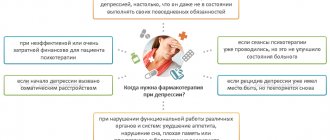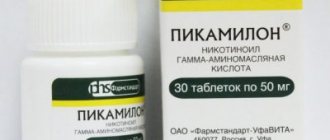Author:
Amelicheva Alena Aleksandrovna medical editor
High blood pressure (arterial hypertension, hypertension) is a persistent increase in systolic blood pressure above 130 mmHg and/or diastolic blood pressure above 90 mmHg.
Blood pressure is the force of blood pressure on the walls of the arteries. High blood pressure is more than normal pressure from the blood against the walls of the arteries.
Causes of high blood pressure
High blood pressure is divided into 2 types:
- primary (essential) hypertension (or hypertension) is the most common type of high blood pressure, often has no cause, develops over many years, the risk increases with age;
- secondary hypertension occurs against the background of the development of any disease (kidneys, endocrine system organs, sleep apnea) or taking certain medications.
Causes of high blood pressure include:
- old age (the older a person is, the higher the likelihood of developing hypertension);
- family history of the disease (high blood pressure in parents or other close relatives);
- unhealthy diet - diet high in salt and fat;
- lack of physical activity;
- overweight, obesity;
- sleep disorders;
- chronic diseases (chronic kidney disease, endocrine disorders, diabetes, high cholesterol);
- race (eg, African Americans have a higher risk);
- gender (in middle age, high blood pressure develops more often in men, in old age - in women; women who had high blood pressure during pregnancy are more prone to arterial hypertension in old age);
- certain medications (contraceptives, decongestants, NSAIDs, antidepressants);
- stress;
- smoking;
- alcohol abuse;
- non-compliance with sleep schedule, night shift work.
High blood pressure is often called the “silent killer” due to its lack of noticeable symptoms. In some cases (especially when blood pressure levels reach dangerously high levels), a person may complain of headache, nosebleeds, and shortness of breath. Many people do not associate these symptoms with abnormal blood pressure readings because they are not in the habit of periodically monitoring their blood pressure with a doctor or at home.
Panic attack: causes, symptoms
This disease can occur due to a number of factors, such as:
- frequent drinking of alcoholic beverages;
- smoking;
- taking narcotic substances;
- diseases of internal organs (heart, pancreas, thyroid);
- constantly being in stressful situations.
In addition, the disease can be transmitted genetically. People whose relatives have suffered from panic attacks have a 15-20% higher risk of developing this disease than others. Also, the likelihood of suddenly experiencing an uncontrollable attack of fear is higher among those who do not lead a healthy lifestyle.
In order to determine the occurrence of such a disease, you need to know its symptoms. The main signs of a panic attack are:
- goosebumps. The release of adrenaline causes blood to move quickly throughout the body. Due to this, people may experience goosebumps and tingling throughout the body, especially near the scalp;
- rapid pulse. A strong heartbeat in an emergency situation is an indicator of a person’s self-preservation instinct, which is a protective function;
- increased sweating. Perspiration may appear on the forehead, above the lip, sweaty palms and armpits;
- frequent breathing. Despite the fact that the lungs are full of oxygen, during a panic attack a person feels as if he is not getting enough air. Therefore, he begins to breathe much more often;
- clouded mind. During an attack, a person loses control over his actions and has little understanding of what is happening around him.
Blood pressure readings
- Normal pressure is from 90/60 mm Hg. Art. up to <120/80 mmHg Art.
- Prehypertension (risk factor for the development of arterial hypertension) - 120–129 mm Hg. Art. / <80 mmHg Art.
- Arterial hypertension 1st degree - 130–139 mm Hg. Art. or 80–89 mm Hg. Art.
- Arterial hypertension 2 degrees - ≥140 mm Hg. Art. or ≥90 mm Hg. Art.*
*American Heart Association classification.
Online blood pressure calculator on the NHS website.
American College of Cardiology online cardiovascular risk (stroke, heart attack and other diseases) calculator (risk of complications for patients with high blood pressure over the next 10 years and beyond).
How often should you check your blood pressure readings?
Blood pressure is usually measured when visiting a doctor (for example, a therapist). There is no need to specifically visit a specialist for this; it is enough to ensure that the pressure is measured at least once every 2 to 5 years, starting from the age of 18 (with normal blood pressure and no increased risk of cardiovascular diseases).
People over 40 years of age, and people 18–40 years of age at risk of high blood pressure, should have their blood pressure checked at a healthcare facility at least once a year. If a diagnosis of arterial hypertension has been established or a person has other risk factors for developing cardiovascular diseases, it is recommended to measure blood pressure more often and not neglect monitoring at home. Your doctor will help you choose a device for measuring blood pressure (tonometer).
For children 3 years of age and older, blood pressure is measured regularly during annual routine examinations.
Caution: The American Heart Association does not recommend the use of wrist- or finger-worn blood pressure monitors, which are less accurate.
If recommended, measure blood pressure at home twice a day on the left and right arm: in the morning before breakfast (but not immediately after waking up) and before taking any medications, and in the evening, preferably at the same time. In each case, you need to measure the pressure 2-3 times (at short intervals, 1-3 minutes) for a confident, accurate result. 30 minutes before, do not smoke, do not eat, do not drink coffee (and alcohol), do not exercise, and empty your bladder. During the measurement, you must sit in a comfortable position, leaning back in a chair or armchair, do not cross your legs and ankles, and do not talk. The arm on which the cuff is worn must be freed from clothing and held at heart level; it is most convenient to place it on a table or armrest of a chair. Don't forget to write down your measurement results.
The role of anxiety disorders in hypertension and the possibility of their correction
In recent years, more and more evidence has accumulated that anxiety and some other psychopathological conditions are independent risk factors for the development of arterial hypertension (AH) and should be considered in conjunction with recognized risk factors [7]. These pathologies increase the morbidity and mortality from hypertension and coronary heart disease (CHD) [2]. Anxiety disorder should be promptly identified and treated, as it worsens the prognosis of somatic pathology [1]. The importance of anxiety disorder in cardiology is confirmed by the results of a prospective 32-year study conducted in the United States by the Centers for Disease Control and Prevention [7], which showed that with increased anxiety, the likelihood of fatal myocardial infarction increases by 1.9 times, sudden death by 4 times. ,5 times. At the same time, social epidemiological studies using objective methods conducted at the State Scientific Research Center for Preventive Medicine showed that the population experienced an increase in the level of psychological stress. It was found that about 70% of the country's population lives in conditions of chronic psychosocial stress of high and moderate levels [3].
In this regard, special attention is paid to studying the role of anxiety in the development of hypertension - one of the main risk factors for coronary artery disease. It is known that hypertension is one of the most common cardiovascular diseases, which affects, in particular, 25–35% of the Russian population. Assumptions that affective disorders, most often anxiety and depression, occupy an important place in the development and course of hypertension were expressed at the beginning of the last century. Currently, work to study the relationship between hypertension and affective disorders is carried out in two directions.
On the one hand, the results of large studies have been published demonstrating the relationship between symptoms of anxiety or depression and the development of hypertension; on the other hand, hypertension is considered as a psychosomatic disease, in the treatment of which psychotropic drugs play a very important role [4].
According to the literature, the prevalence of neurotic and somatoform disorders with anxiety symptoms in patients with hypertension can reach 51.3% [2, 5]. However, the number of studies is limited and clear recommendations for the management of such patients do not exist. It is known that comorbid anxiety-depressive disorders, like hypertension, themselves lead to a significant decrease in working capacity, while they aggravate the course of somatic illness and contribute to the formation of a hypochondriacal type of internal illness [7]. In this regard, it seems very interesting and important to determine the possibility of the influence of complex therapy with antihypertensive drugs and a “daytime” anxiolytic on the course of hypertension in patients with anxiety.
Anxiolytic therapy significantly improves the quality of life of patients with cardiovascular diseases, promotes their better compensation in the process of somatotropic therapy, and subsequently adaptation to the disease. Tranquilizers are the most adequate, effective and safe drugs for the relief of adaptation disorders in cardiac patients [2, 3]. However, patients often avoid taking benzodiazepines for fear of developing symptoms of addiction, unpleasant side effects such as lethargy, muscle weakness, and impaired attention. Elderly patients are often afraid of developing coordination problems due to the fear of falling and the appearance of instability.
Taking into account the noted problems, in recent years there has been an increasing need for drugs with a tranquilizing effect of the non-benzodiazepine series. These drugs include Tenoten.
The drug Tenoten is an ultra-low dose (USD) to the brain-specific protein S100. The mechanisms of action of anti-S100 SMD in anxiety conditions are probably associated with modification of the functional activity of the endogenous S100 protein and its ligands. As a result, its GABA-mimetic effect is realized and GABAergic neurotransmission is restored. The clinical effect is manifested by facilitating falling asleep, reducing behavioral manifestations of anxiety, improving memory, and reducing asthenia.
The purpose of the study was to evaluate the effectiveness and tolerability of combined treatment with antihypertensive drugs and the anti-anxiety drug Tenoten in patients with hypertension. The duration of the study is 4 weeks.
The study involved 60 patients with hypertension aged 61.41 ± 6.91 years (from 38 to 77 years). The patients were randomly divided into two groups (main and control) of 30 people each. There were 18 men and 12 women in the main group, and 19 men and 11 women in the comparison group.
In the main group, hypertension with a moderate course (grade II) was observed in 60% of patients, with a severe course (grade III) - in 40%; in the comparison group, there were 66.6% of patients with a moderate course, and 33.4% with a severe course. The average duration of hypertension disease was 10.61 ± 4.1 years (from 3 to 20 years).
Family history, lifestyle, risk factors and concomitant pathologies are of great importance in the course of hypertension.
Persons with symptomatic hypertension and complicated forms of hypertension were excluded from the study.
In the comparison group, patients received only antihypertensive therapy - ACE inhibitors, β-blockers, diuretics (Enap, Hypothiazide, Acridilol, Arifon). Patients of the main group received combination treatment with antihypertensive drugs in combination with Tenoten, which was prescribed according to the scheme: 6 tablets per day for the first 2 weeks, and then 1 tablet 3 times a day.
Treatment was prescribed for a month. Dynamic monitoring was carried out at the beginning of the study, after 2 and 4 weeks of therapy.
To assess mental status, we used the Personal Anxiety Scale (J. Teylor), which is designed to measure the level of anxiety (adapted by T. A. Nemchininov).
The questionnaire consists of 50 statements. The results of the study are assessed by counting the number of responses from the subject indicating anxiety; the total score is:
40–50 points is an indicator of a very high level of anxiety;
20–40 points – high level of anxiety;
15–20 points – average level of anxiety with a tendency to high;
5–15 points - average level of anxiety with a tendency to low;
0–5 points—low level of anxiety.
A study of the mental status of patients in both groups revealed anxiety symptoms of varying severity in a significant proportion of patients. The number of patients with an initial high level of anxiety was 40% in the main group and 43% in the comparison group. The number of patients with an initial average level of anxiety with a tendency to high was 60% in the main group and 56.6% in the comparison group.
Research results
By the end of the study, the high level of anxiety decreased in the main group by 39.39% and reached an average level of anxiety with a tendency to low, while in the comparison group the level of anxiety decreased by only 3.6%.
In patients of the main group who took Tenoten, a clear decrease in the level of anxiety was noted after 2 weeks and by the end of the month reached significance in comparison with the group of patients who received standard antihypertensive therapy. Relief of affective disorders was accompanied by a decrease in complaints of anxiety, feelings of helplessness, self-doubt, a sense of impending danger, and poor sleep (Table 1).
The demonstrated differences in the dynamics of anxiety indicators in the studied groups of patients confirmed the possibility of effective correction of these disorders in patients with hypertension with the drug Tenoten. However, it was extremely interesting to assess whether this therapy and the severity of concomitant anxiety disorders influence the effectiveness of antihypertensive therapy in general.
A decrease in the values of maximum systolic and diastolic pressure occurred in both study groups. By the end of the month of treatment, the decrease in blood pressure (BP) reached statistically significant significance. In the main group of patients who additionally took Tenoten, systolic blood pressure (BP) decreased by 24.28% - almost to the age norm; in the comparison group there was a decrease of 16.48%, i.e. a slight excess of normal values was noted. The decrease in diastolic pressure by the end of the 4th week in the main group (by 17.7%) and in the comparison group (by 5.9%) was also significant (Table 2).
The addition of Tenoten to complex therapy in patients with high and moderate levels of anxiety allowed us to achieve a significantly more pronounced improvement in blood pressure. During Tenoten therapy, a more rapid effect of antihypertensive drugs is observed - after 2 weeks of combined use of the drug in patients of the main group, blood pressure decreased to the target level, in contrast to the comparison group, where it remained above the target.
Conclusion
The results of our study show that all patients with hypertension exhibit anxiety symptoms of varying severity, which aggravate the course of the disease, contributing to higher increases in the level of both systolic and diastolic blood pressure. The inclusion of the modern “daytime” anxiolytic Tenoten in the complex therapy of patients with hypertension increases the effectiveness of the treatment, reduces the level of anxiety, which contributes to a more rapid onset of the hypotensive effect. Tenoten is well tolerated by patients and does not cause orthostatic hypotension or any other undesirable side effects.
Literature
- Avedisova A. S. Anxiety disorders // Yu. A. Aleksandrovsky. Mental disorders in general medical practice and their treatment. M.: GEOTAR-MED, 2004. pp. 66–73.
- Kopina O. S., Suslova S. F., Zaikin E. R. Population studies of psychosocial stress as a risk factor for cardiovascular diseases // Cardiology. 1996. No. 36 (3). pp. 53–56.
- Sudakov K.V. Emotional stress and arterial hypertension. M.: VNIIMI, 1976.
- Chazov E.I. Coronary heart disease and the possibility of increasing the effectiveness of its treatment // Clinical trials of drugs in Russia. 2001. No. 1. P. 2–4.
- Kawachi I., Sparrow D., Vokonas PS, Wess ST Symptoms of anxiety and risk of coronary heart disease. The Normative Aging Study. Circulation. 1994; 90, 5: 2225–2229.
- Lavie C., Milani R. Prevalence of anxiety in coronary patients with improvement following cardiac rehabilitation and exercise training. Am J Cardiol. 2004; 93:336–339.
- Sonas BS, Franks P., Ingram DD Are symptoms of anxiety and depression risk factor for hyprtension? Longitudinal evidence from the National Health and Nutrition Examination Survey I Epidemiologic Follow-up Study. Arch. Fam. Vtd. 1997; 6:43–9.
I. N. Nikolskaya , Doctor of Medical Sciences, Professor I. A. Guseva , Candidate of Medical Sciences, Associate Professor E. V. Bliznevskaya , Candidate of Medical Sciences, Associate Professor T. V. Tretyakova , Candidate of Medical Sciences NSMU, Medical Unit No. 25, g Novosibirsk
Is it possible to normalize high blood pressure and what to do?
Yes, with the help of lifestyle modification (influencing modifiable factors), treating the underlying disease, taking medications that normalize blood pressure.
Lifestyle modifications include proper nutrition, including avoiding fatty foods and reducing salt intake (the DASH (Dietary Approaches to Stop Hypertension) eating plan recommended by the US National Heart, Lung, and Blood Institute is preferred); weight normalization; quitting smoking and alcohol; regular physical activity; stress management (for example, mastering relaxation techniques).
If you have persistently high blood pressure due to a medical condition (such as diabetes) or caused by taking certain medications, it is recommended that you consult your doctor. Control of the underlying disease, refusal of drugs (or their replacement) that increase blood pressure, make it possible to stabilize the patient’s blood pressure and condition.
Nonmodifiable risk factors associated with high blood pressure include age and family history.
Treatment of high blood pressure
Treatment of arterial hypertension is based on lifestyle modification, constant monitoring of blood pressure, and the use of antihypertensive drugs (medicines that lower blood pressure) - one or more, based on the patient's individual situation.
Medicines prescribed for high blood pressure include: ACE inhibitors, angiotensin II receptor inhibitors, calcium channel blockers, diuretics, beta blockers, alpha blockers, alpha beta blockers. In most cases, these medications do not cause side effects. However, you should not self-medicate; you should consult a doctor who will select an effective drug and prescribe a regimen for its administration. It is important to follow all recommendations, observe the dosage and not skip taking the drug(s).
When diagnosing arterial hypertension, 24-hour blood pressure monitoring (ABPM) provides an accurate idea of the patient’s blood pressure levels. ABPM also excludes the factor of chance, distortion of real blood pressure readings (the so-called “white coat” syndrome or “white coat” hypertension), and registers imperceptible changes in blood pressure (for example, during sleep). This test is recommended by the American Heart Association to confirm the diagnosis of hypertension.
Treatment of manifestations of VSD in Moscow
Medicine has always developed dynamically, and at the moment there is a whole host of effective treatment methods. The specialists of the Yusupov Hospital, using their accumulated knowledge and skills, never cease to absorb new knowledge. There is no panacea for all diseases, but this is not a reason to be alone with your problems. The clinic’s doctors find an individual approach, select the treatment necessary in a particular case, provide comfortable conditions, and help where your body could not cope. Don’t put up with the symptoms - make an appointment by calling the Yusupov Hospital.








